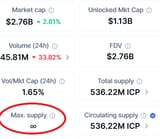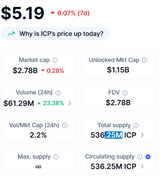>>60746474
>>60746843
>>60747055
>>60747055
I'm an ICP investor, and I'm genuinely interested in this tech, so I've taken this to be a learning opportunity for me. Here is what I've found. Nakamoto Coefficient is a metric that measures the decentralization of a blockchain network by indicating the minimum number of independent entities needed to control or disrupt the network. There is no "single" Nakamoto Coefficient (NC) for ICP, but I think it is fair to say that NC=5 for typical application subnets, and NC=12 for the entire network.
If you open the subnet list on the Internet Computer Dashboard, you can see the Nakamoto coefficient listed for every single subnet, including a breakdown by potential actor categories (Node Providers, Data Centers, Data Center Owners, Regions, and Countries). You can see the list of nodes here:
https://dashboard.internetcomputer.org/network/subnets?sort=desc-total_nodes
ICP uses a Byzantine Fault Tolerant (BFT) consensus. In BFT networks, to compromise a subnet, an attacker (or colluding operators, which by no means is trivial due to protection mechanisms) must control:
≥33% of nodes to disrupt liveness (halt the subnet).
≥66% of nodes to execute malicious transactions (e.g., double-spend).
A typical application is deployed to an ICP subnet of 13 nodes. Here is a sample subnet:
https://dashboard.internetcomputer.org/network/subnets/2fq7c-slacv-26cgz-vzbx2-2jrcs-5edph-i5s2j-tck77-c3rlz-iobzx-mqe
A subnet’s nodes are hosted by different node providers. So to halt a typical application subnet, it would require 5 providers in collusion to freeze the subnet from producing new blocks (⅓) and 9 providers to actually falsify transactions.
There are a few “super-sized” subnets right now. The System (NNS) subnet has 40 nodes. You can see directly on the Internet Computer Dashboard how actors it would take to compromise the network. In this case, it would require 12 node providers to collude to halt the entire network.












